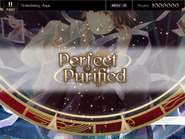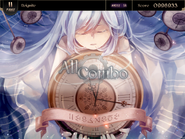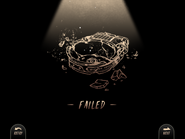Lanota's gameplay revolves around tapping, catching, flicking, and holding notes at the rim of a large wheel, known in-game as the Notalium Tuner. It is the player's job to clear these notes as accurately as they can to the beat of the background music, while keeping up with the Tuner's movements.
For a more interactive guide, see the in-game tutorial. It can be accessed from the menu.
Menus, Screens and Buttons
See also: User Interface
Selecting a Song
Lanota's song select screen is an overworld map after the title screen. Tap the crystals in spinning gears to select songs, or the various landmarks around them.
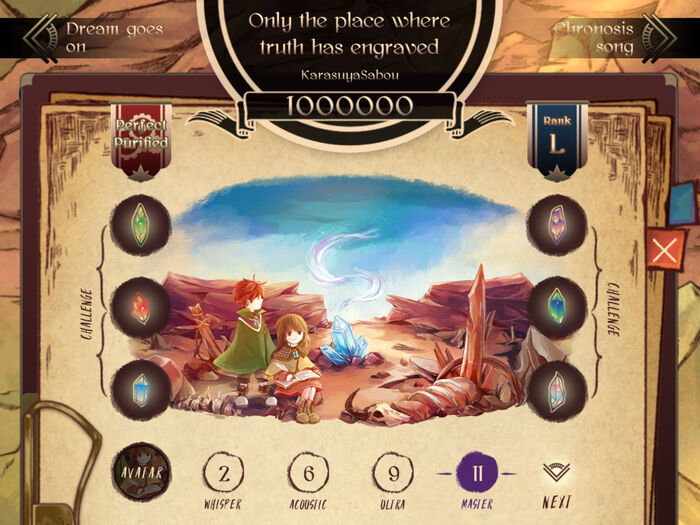
What a song looks like before a play
Pressing the Next arrow, or anywhere on the picture, will take the player to the next part of song selection.
Song Settings
Once the player presses the Next arrow on the bottom right, they will arrive at the song settings. There, the player can choose:
- Their Speed Option, which is how fast they want the notes to fall. The slowest is 1 (1/3x) and the fastest is 9 (3x); by default, Lanota will set it to 3 (1x). The best/most comfortable speed will depend on individual players, but the recommended speed is from 3 (1x) to 7 (7/3x).
- If the player can not find a speed they like within integers, they can check the Advanced checkbox to get more precise numbers, such as 4.8 (1.6x).
- The Fast/Slow timing indicator, which tells the player whether they are hitting notes too early or late.
- Their Song Mode (available after clearing Chronosis song) (Tune and Purify).
- Show in-song early/late indicator, whether a note is tapped/flicked too early/late. Currently only available with the Platinum Subscription.
Once the player decides what song settings they want, all that is left is to hit the Start button.
Pause Menu
To pause a song in Lanota, the player must tap the pause button twice. There, they will get three options:
- Resume lets them keep going.
- Retry restarts the song and puts the player's score and combo back at 0 (not available for the free version on Android or select songs, such as Bloody Marquis).
- Retire takes the player back to the overworld map.
Difficulties
Like most other rhythm games, each of Lanota's songs has multiple levels in multiple difficulties, each difficulty being rated by a level rating from 1 to 15 (however Stasis, SolarOrbit, Wolves Standing Towards Enemies and Astaroth Master charts are level 16). They look like this:
- Whisper, which is the easiest available, is better for beginners (levels 1-6). (equivalent to Easy)
- Acoustic, which is reasonably hard, is for all kinds of players (levels 3-10, but Stasis, Wolves Standing Towards Enemies and Astaroth which is level 13). (equivalent to Medium)
- Ultra, which poses a bit of a challenge, is good for more experienced players (levels 6-14, except Stasis and SolarOrbit, Wolves Standing Towards Enemies and Astaroth (which are level 15). (equivalent to Hard)
- Master, which is as hard as it possibly gets, is for those who have strong confidence in their playing skills (levels 9-16). (equivalent to Expert)
The first three difficulties are available the first time a player picks a song. Master is unlocked after beating Ultra with a A Rank or higher, or by using Starlight Score unlock Master immediately (requires 300 Notalium units in posession). On the Switch version, Master is unlocked by default.
Note Types
Notes are a crucial part of Lanota. They appear as curved bars in varying sizes and colors. The color of a note is determined by what type it is. Currently, there are four types:
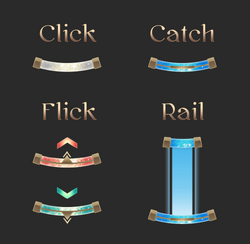
All the note types in Lanota
Click Notes
These are white, and each must be tapped to be cleared.
Catch Notes
Similar to Click Notes, except they are blue with a bronze bar at the center. To clear these notes, the player does not have to tap each one. They can keep their finger held down at the rim of the Tuner and move it as necessary. It is possible to tap these notes, where they will always give a harmony rating when done so.
Flick Notes
These have arrows and come in two colors: red and green. Red notes are meant to be flicked toward the center of the Tuner, while green notes are meant to be flicked outward from the center.
Rail Notes
Similar to Catch Notes, but these have a rail (blue bar) that the player must keep their finger on for as long as it keeps falling. Every half beat a Rail note is held for adds to the combo and gives you a Harmony, and every half beat it is not held for counts as a Fail.
Challenges
Challenges are another aspect in Lanota. They are found on the sides of each song.
- For main stories and side stories, the player must complete the song at least once to reveal 3 challenges. The challenges are shown when the Notalium crystals on the side of the levels are tapped.
- Songs from Subscription Chapter. ∞ have no challenges, though they have unlockable avatars.
- For expansion chapters, a song only has 3 available challenges by default.
- If the player has not completed all the challenges, the words "More to Challenge" appear in The Lanota Alphabet.
- When all the challenges are cleared, an icon will appear at the end of the song, saying "Challenge all Completed".
As the player completes more challenges, additional challenges will appear; up to 6 for each song. Completing them rewards the player with Notalium, which is added to the total amount the player has collected. Harder challenges give the player more Notalium, while easier ones give less. The Notalium acquired from challenges has no effect on storyline or items, though it provides a boost to the amount of Stabilized Sound the player receives after playing a song.
Score
Summary Table
| Judgment | Combo | Purify Gauge |
|---|---|---|
| Harmony | Yes (adds to combo) | Up (+1 pt) |
| Tune | Yes (adds to combo) | Up (+0.5 pts) |
| Fail | No (breaks combo) | Down (-11 pts) |
Scoring
For each notes successfully hit, the player's score counter will increase by an amount. The amount is determined depending on the judgment and their current combo.[1]
Judgment scoring: Lanota judges the accuracy of a player's note hit with one of three words: Harmony, Tune, and Fail. This makes up 92% of the total score of any chart. (920,000 pts)
- Harmony is marked by golden or red text and a gold or red smoke effect. Harmony (golden text and red smoke effect) is when a click or flick note is tapped or flicked completely at the exact time or very slightly early/late, or from holding catch/rail notes.
- Tune is marked by blue text and a blue smoke effect. It is when a click or flick note is tapped or flicked slightly early/late.
- Fail is marked by dark red-brown text and no effect. It is when a click or flick note is tapped or flicked way early/late or not at all, or when a catch or rail note is not held.
Each note in any given chart carries the same amount of points in terms of judgment scoring:
The judgment constant is determined by the judgment that the player got when they hit the note:
- Harmony awards full points.
- Tune awards of the note's score (approx. 43.4782%), i.e. .
- Fail awards 0 points and breaks the combo.
Combo scoring: Combo refers to the number of consecutive notes a player taps on and gets a non-Fail judgment (i.e. Harmony or Tune). This makes up 8% of the total score of any chart. (80,000 pts)
Combo also greatly affects the player's score. They are unaffected by judgment multiplers, and unlike in other rhythm games where the amount of points gained from combos increases, or stays the same as one builds up a combo, it actually decreases in Lanota.
The most fundamental decrease to combo score is called the combo score unit:
The player only gains combo score if their current combo prior to hitting the note, is at least equal to their max combo.
Up to half the note count of any chart, the combo score is calculated as follows:
Once the max combo reaches half the note count (rounded down), combo score will drop significantly over the next couple of notes:
- If the song's note count is odd, the very note that made the max combo exceeded half the note count will lose points equal to compared to the previous one, and for the very next one, where:
- If the note count is even, the very note that made the max combo exceed half the note count will lose points equal to , where .
After the combo score is fully decreased, each following notes carry points in terms of combo score, which makes each note on the second half of any given chart award a maximum of points.
- The max combo rule still applies here, meaning that if one misses a note on the second half of the song, they won't get any more combo score thereafter.
- This also means that if a chart's note count is even and one has hit only Harmony notes for exactly half the note count of a chart without Failing once, they would have 520000 points.
Example
Take Clock Atelier (Whisper) as an example (Note count: 400):
Judgment scoring
- Harmony awards 2300 points.
- Tune awards 1000 points.
Combo scoring
When the player hit the first note of the chart with a Harmony judgment, they would get:
- This is shown in-game as 2699 as typecasting a floating point number to int will round it down.
If they hit it with a Tune judgment instead, they would get:
- This is shown in-game as 1399 as typecasting a floating point number to int will round it down.
Likewise, hitting the second, third, etc. note without breaking the combo will award 2698.5, 2697.5, etc. points given that they hit it with a Harmony judgment.
- When scores are added up, ±1 pts of error might be visible in-game due to rounding.
Second half combo score
After reaching 200 max combo, which is half the note count, the combo score is
Hitting another note to bring the max combo to 201 will see the combo score drop by
,
bringing it down to 100, which is also
- If one doesn't break the combo, a note hit with Harmony judgment will award 2400 points, and 1100 for Tune thereafter.
Impact of max combo to total score
Take Clock Atelier (Whisper) as an example (Note count: 400):
- A player got 1 Fail on the chart while hitting all others with a Harmony rating, and also got a max combo of 250. That player would get
- Another player also got 1 Fail on the chart while hitting all others with a Harmony rating, but got a max combo of 300. Their score would be
As can be seen, while both players practically had the same accuracy, a higher max combo led to a higher score for the latter. Therefore, it is vital that one maintain a good combo as well as hitting the notes correctly for a higher score.
Ranks
The player's score is determined by how many notes they clear, and how accurate their hits were, ranging anywhere from 0 (all Fail) to 1,000,000 (all Harmony).
| Rank | Score | Mathematically |
|---|---|---|
| D | 499,999 or below | Score ≤ 499,999 |
| C | 500,000 ~ 699,999 | 500,000 ≤ Score ≤ 699,999 |
| B | 700,000 ~ 899,999 | 700,000 ≤ Score ≤ 899,999 |
| A | 900,000 ~ 949,999 | 900,000 ≤ Score ≤ 949,000 |
| S | 950,000 ~ 979,999 | 950,000 ≤ Score ≤ 979,999 |
| L | 980,000 ~ 1,000,000 | 980,000 ≤ Score ≤ 1,000,000 |
Titles
After a play, you will be given a title describing your result. Titles below are ordered from low to high, and higher titles will always overwrite lower titles, while lower titles will never overwrite higher titles.
| Title Name | Description |
|---|---|
| Tuned | Play the song in Tune mode (equivalent to "Played" / "Failed") |
| Purified | Survive the whole song in Purify mode (equivalent to "Cleared") |
| All Combo | Play the song in any mode and not get a Fail. (equivalent to "No Miss" or "Full Combo") |
| Perfect Purified | Play the song in any mode and hit all notes with a Harmony judgement, i.e. a no-Tune All Combo. (equivalent to "All Perfect" or "Perfect Full Combo") |
Rating
As of version 2.1, depending on how the player performed on a song, they will gain, lose, or keep their rating.
Gallery
Trivia
- There used to be a bug in which Notalium would be given for challenges even when they were not completed. This occurred for "hit every Click notes" challenges, where the player could complete it without fulfilling its requirement. This was patched in a subsequent update.
- The Fast/Slow timing indicator was given to all players in version 2.6.0.























